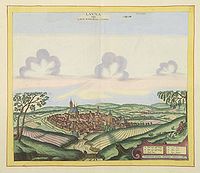Exceptional coloring

Wealthy collectors, Kings, noblemen and rich merchants ordered atlas to be colored in exceptional colors and sometimes heightened in gold and silver. Some colorists are known. Dirk Jansz. van Santen was the most famous. Others are Frans Koerten, David Reerigh and Anna Beek.
A master colorist like Dirk Jansz Van Santen (1637/38-1708) worked for Kings and rich merchants. ![Old map by BLAEU - Bressia vulgo Bresse. [Coloured by Van Santen] santen](/images/mapimg/29235.jpg) His manner is signified by rich and exotic color combinations, added elements such as flowers to clothing, and marbling to masonry. Goedings : "Van Santen applied transparent and opaque colors simultaneously in mixed and pure tints. He often painted the whole surface of the map or illustration, transforming the graphic light and dark contrasts into color.
His manner is signified by rich and exotic color combinations, added elements such as flowers to clothing, and marbling to masonry. Goedings : "Van Santen applied transparent and opaque colors simultaneously in mixed and pure tints. He often painted the whole surface of the map or illustration, transforming the graphic light and dark contrasts into color.
Atlases and books colored by van Santen are found in the libraries of the most prominent collectors of the golden age of Dutch cartography ". Bibles and atlases, bound in deluxe bindings by Albert Magnus (1642-1689) and decorated by van Santen were considered gifts worthy of princes. Travelers and poets wrote about this work" (Goedings).
More about Dirk Jansz van Santen >>>Frans Koerten
Another famous Dutch colorist was Frans Koerten, (1603-1668), illuminator, bookseller and collector, whose
stock and the private collection was sold at auction in Amsterdam in 1668 but also the engraver and publisher of prints.
 Mrs. Anna Beek of the Hague. She enlarged
prints, originally published by Hogenberg or Merian, and colored them in pastel colors, adding extensive
clouds and brilliant yellow borders. The height of the prints are often enlarged by ca. 8 cm (3 inches). This way of enlarging prints is also known from the famous Van der Hem/Prinz Eugen Atlas and those in the former Royal print collection kept in Jemniste in Czechoslovakia. We are unaware of prints heightened with gold, but the result is evenly impressive and worthy for a King or nobleman.
Mrs. Anna Beek of the Hague. She enlarged
prints, originally published by Hogenberg or Merian, and colored them in pastel colors, adding extensive
clouds and brilliant yellow borders. The height of the prints are often enlarged by ca. 8 cm (3 inches). This way of enlarging prints is also known from the famous Van der Hem/Prinz Eugen Atlas and those in the former Royal print collection kept in Jemniste in Czechoslovakia. We are unaware of prints heightened with gold, but the result is evenly impressive and worthy for a King or nobleman.
More about Anna Beek >>>
Besides, in the Netherlands, other colorists in other countries are known.
Georg Mack Jr. was one of the most famous German colorists of his time; he continued the work of his father Georg (ca. 1556 - 1601) and his grandfather Hans (ca. 1536-1585). Georg Jr. established his own workshop in 1582. He was active in Nuremberg and colored the flower books by Besler.
Grisaille
Illuminated manuscripts were often produced in pen and wash color with a very limited color range. Many artists such as Jean Pucelle and Matthew Paris specialized in such work, which had been especially common in England since Anglo-Saxon times.
Renaissance artists such as Mantegna and Polidoro da Caravaggio often used grisaille as a classicizing effect, either in imitation of the effect of a classical sculptured relief, or of Roman painting.
In the Low Countries a continuous tradition of grisaille paintings can be traced from Early Netherlands painting to Martin Heemskerck, Pieter Brueghel the Elder, Hendrik Goltzius, the circle of Rembrandt, and Jan van Goyen.